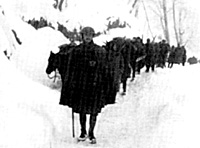
The Italians attacked 28 October 1940. Mussolini had ordered his troops to attack into difficult mountain terrain at the beginning of winter, but most Italian units were completely untrained or equipped for the mission. Almost immediately the Greeks stopped the Italian advance.
After a few weeks of defensive fighting, the Greeks went on the offensive and drove deep into Albania. The weather was horrible, the troops on both sides suffering greatly from the cold. The front stabilized just south of Valona after more Italian troops had poured in. A huge Italian counter-offensive in February 1941 went nowhere and a small British ground contingent began to arrive in Greece. Mussolini would have to swallow the humiliation of accepting German aid.
The German attack on 6 April 1941 was made to save their ally from defeat and to eject the British from Europe once again. It was carried out with an efficiency and thoroughness greatly in contrast with the Italian offensive of the previous autumn. By the end of April, all resistance had ceased in mainland Greece, the British contingent (two infantry divisions and an armored brigade) had evacuated with a small portion of the Greek Army.
The German airborne invasion of the island of Crete in the following month brought under occupation the last portion of Greek territory.
Construction of the Olympus and Aliakmon Lines was never completed.
Partial Bibliography
Cruishank, Charles; Greece 1940-1941; University of Delaware Press: Cranbury, 1975.
Greece: Stratos Dienthysis Historias; To Telos Mias Epopollas Aprilios 1941 Hellenic Publishing Ltd: Athens, 1959.
Gardiner, Robert, Ed.; Conway's All the World's Fighting Ships 1922-1946; Conway Maritime Press: London, 1980.
Mollo, Andrew; The Armed Forces of World War II; Crown Publishers: New York, 1981.
Papagos, Alexander; The Battle of Greece 1940-1941; Hellenic Publishing Ltd: Athens, 1949.
Prieskop, Franklyn; Notes on the Greek Army; unpublished, circa 1978.
Shores, Christopher and Cull, Brian; Air War for Yugoslavia and Greece; Squadron/Signal Publishers: Carrollton, 1987.
The Greek Armed Forces in 1940-41
Back to Europa Number 32 Table of Contents
Back to Europa List of Issues
Back to MagWeb Master Magazine List
© Copyright 1993 by GR/D
This article appears in MagWeb.com (Magazine Web) on the Internet World Wide Web. Other articles from military history and related magazines are available at http://www.magweb.com